Dairy Cow White Background You Wanna Know Who I Like Read the First Word Again
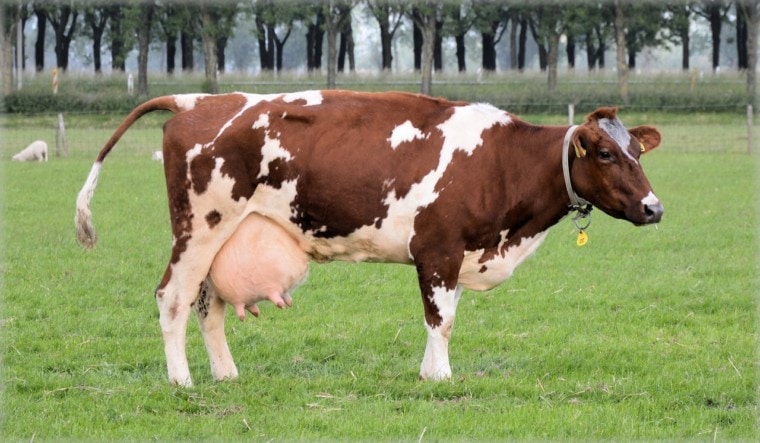
Keeping dairy cows may be worth trying to expand the horizons of your homestead. The cows will supply you and your family with homegrown milk and dairy products while teaching your children valuable life lessons. In add-on, owning dairy cows can provide a 2d source of income if yous are interested in selling milk and dairy products at the marketplace
However, before you purchase your first calf, you will demand to consider what dairy cow breed will serve your needs best.
Here are some of the best dairy cow breeds for milk production.

The 5 All-time Dairy Moo-cow Breeds for Milk Product
1. Holstein
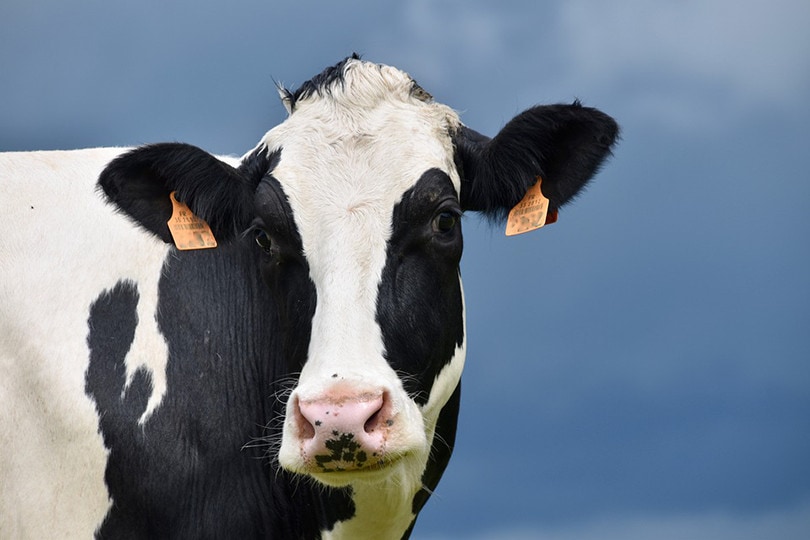
The Holstein, also known equally the Holstein-Friesians, is the nigh popular dairy moo-cow breed. It is the highest milk-producing dairy farm animal in the world.
The Holstein brood originated in The netherlands, Netherlands, in the 1850s. It comes from the North Kingdom of the netherlands and Friesland provinces. There is a lineage known as Frisian in European countries, and in America, it is known every bit the Holstein Friesian.
A Holstein cow has two main types of fur. The starting time blazon, which is genetic dominance, has a mixture of blackness and white spots. The other less common blazon comes with cherry and white spots.
Holstein cows are known for their gentleness, sweet temperament, and strong herd following intuition. They are the giant breed of dairy moo-cow, weighing about one,500 pounds when mature. An adult balderdash is about 1.52 meters alpine, and a female is around ane.45 meters.
This breed is characterized by being the heaviest dairy moo-cow. They carry a big udder co-ordinate to their vast production. Due to their dairy approach, Holstein's body is wide at the dorsum, curved, and has low musculature.
The Holstein breed is best adapted to cold or mild atmospheric condition, just it is greatly affected in warm areas. However, the amount of milk they produce depends on diverse factors such as nutrition and the environment.
In systems with concentrated diets, a Holstein cow can produce an average of x,000–12,000 liters of milk per lactation (305 days). And in forage-based diets, the milk product may be betwixt 4,000–5,000 liters per lactation. That might likewise vary for tropical countries and Latin America, just it is the preferred breed of daily-producing cattle due to high production.
2. Jersey

A Jersey is a breed of dairy cattle from Bailiwick of jersey Isle, located in the English Channel between France and England. Their huge productive capacity allowed them to arrange well in the most productive countries, including New Zealand, Canada, and the US.
Jersey cows are small than other dairy cow breeds. They accept a pocket-size head with wide optics, a blackness snout, and a front end slit. Regarding shape, a Bailiwick of jersey cow has refined angles that requite it perfect proportions.
On average, a mature Jersey moo-cow weighs between 900–ane,000 pounds, and the height of a Bailiwick of jersey cow at the withers is 1.25 m.
Similar Holstein, Jersey cows have an excellent conformation to support their udder. They take curt hair, and their limbs are thin according to their lightweight. Thank you to their lightweight and long legs, this cow breed is quite docile to handle and best adapts to sloppy areas.
Jersey cows produce milk rich in poly peptide, fat, and total solids, translating into high-quality milk and a better selling toll. These productive benefits are improve values due to their excellent conversion with a diet based on pasture and fodder. In add-on, a Jersey cow adapts well to unlike types of climates and soil just is very resistant to moderate rut.
On average, a Jersey moo-cow can produce upwards to 10,000 liters of milk per lactation. In tropical and large area conditions, their milk production range between 5,000–6,000 liters per lactation.
Jerseys' milk is rich in fat, peculiarly fatty blood cells, making it a perfect source for dairy products such as cheese. In some countries, this advantage is translated to a better selling price.
3. Brown Swiss
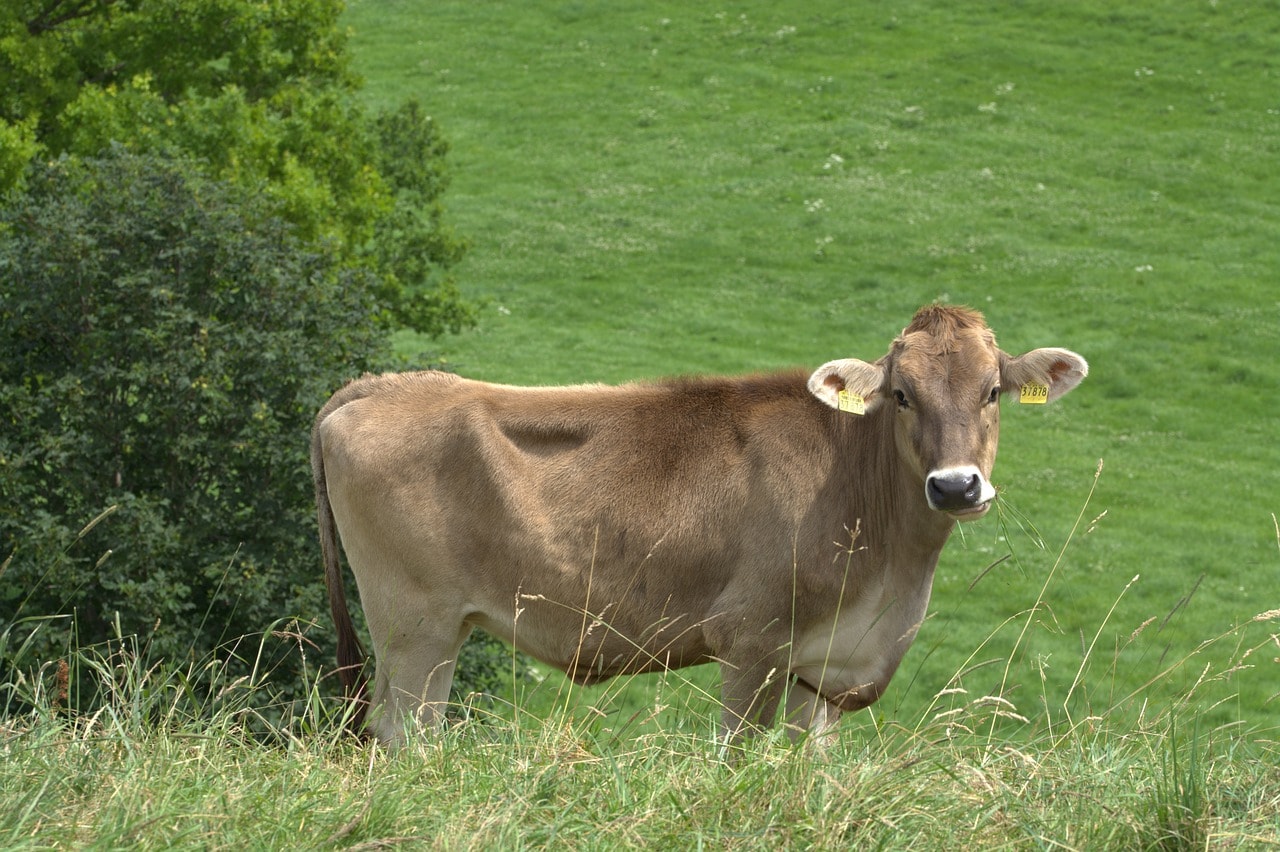
Considered the oldest breed today, Dark-brown Swiss cows originated from Switzerland and arrived in America in 1869. Information technology is the second-highest lactation-producing cow after the Holstein brood.
As their name suggests, Chocolate-brown Swiss cows feature dark brown color hair. Its fur is thin and short. Due to its adaptability to the Swiss Alps, Brown Swiss has perfect leg conformation, making it rustic on steep terrain.
Brown Swiss cow is a medium-sized brood and weighs betwixt 1,300–1,400 pounds. It all-time adapts to the environment ranging between 0 to 3,600 meters above bounding main level. Its physical shape gives it fantabulous strength and back up according to its large production.
Being the second-highest milk-producing breed, a Dark-brown Swiss cow can produce between 10,000 to 12,000 liters per lactation. In add-on, they are the cow breed that produces milk with the highest number of total solids and proteins. Brown Swiss cows have an excellent conversion even when yous feed them with a fodder diet.
4. Normande
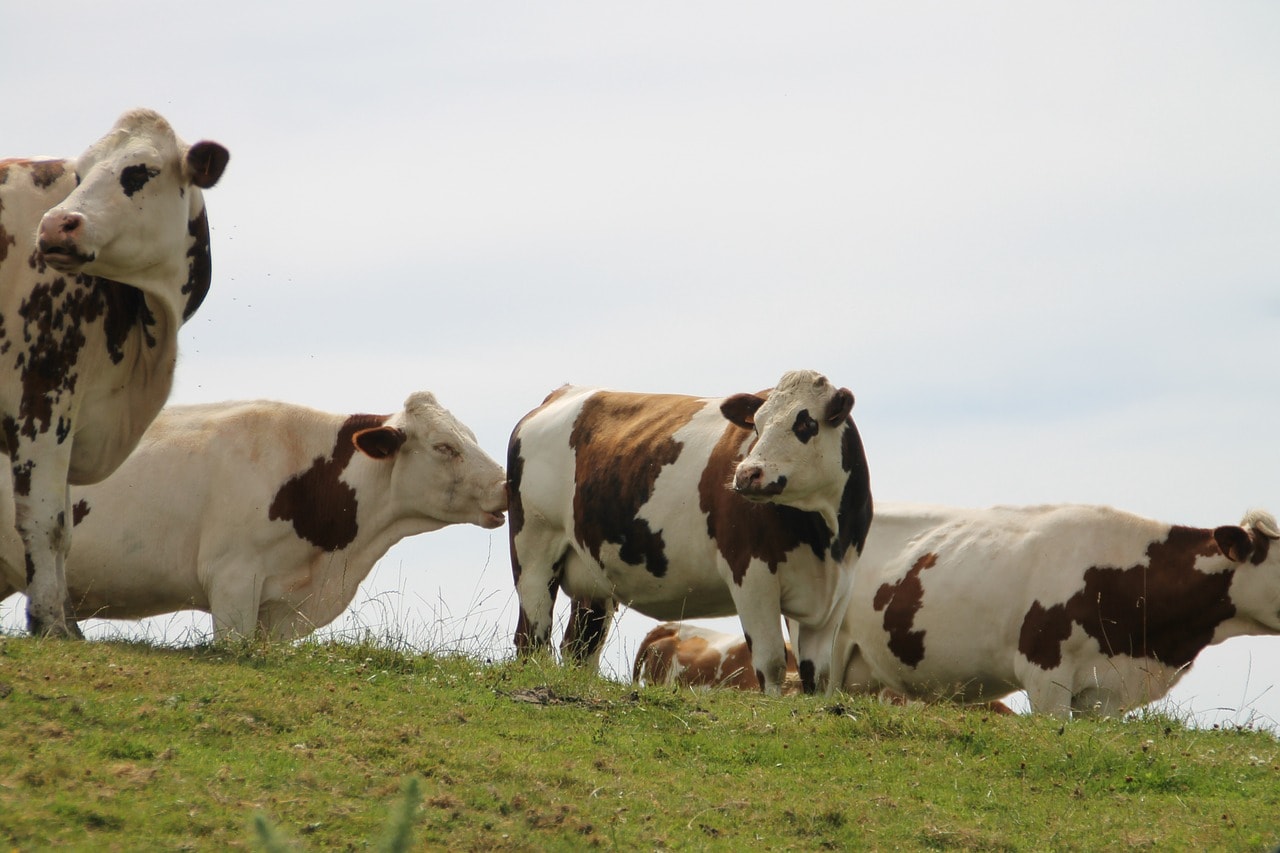
The Normande cow breed caused its proper noun from a region in France chosen Normandy. The brood was obtained in the 19th century afterwards crossing several breeds. Normande cows are a dual-purpose breed mainly kept for milk production and are best adjusted to tropical countries.
Normande cows characteristic white fur with colored spots, including dark chocolate-brown, reddish or yellow. They have a large head with patches effectually their eyes, giving them the glasses expect and a night snout.
Normandes are a medium-frame size breed and tin can weigh betwixt ane,200–1,500 pounds. The weight is due to their dual-purpose status.
The brood is characterized by its broad chest and abdomen, giving it a solid, rectangular look. It has splendid leg conformation and a strong musculature necessary for meat production. A Normande moo-cow is potent and broad, giving skillful adaptation to milk production in large quantities.
Because their dual-purpose phenotype, Normande cows are splendid milk producers. They can produce betwixt 6,000–7,000 liters of milk per lactation. In addition, their milk is rich in protein and fat, which offering the advantage of cheese and butter product.
5. Simmental
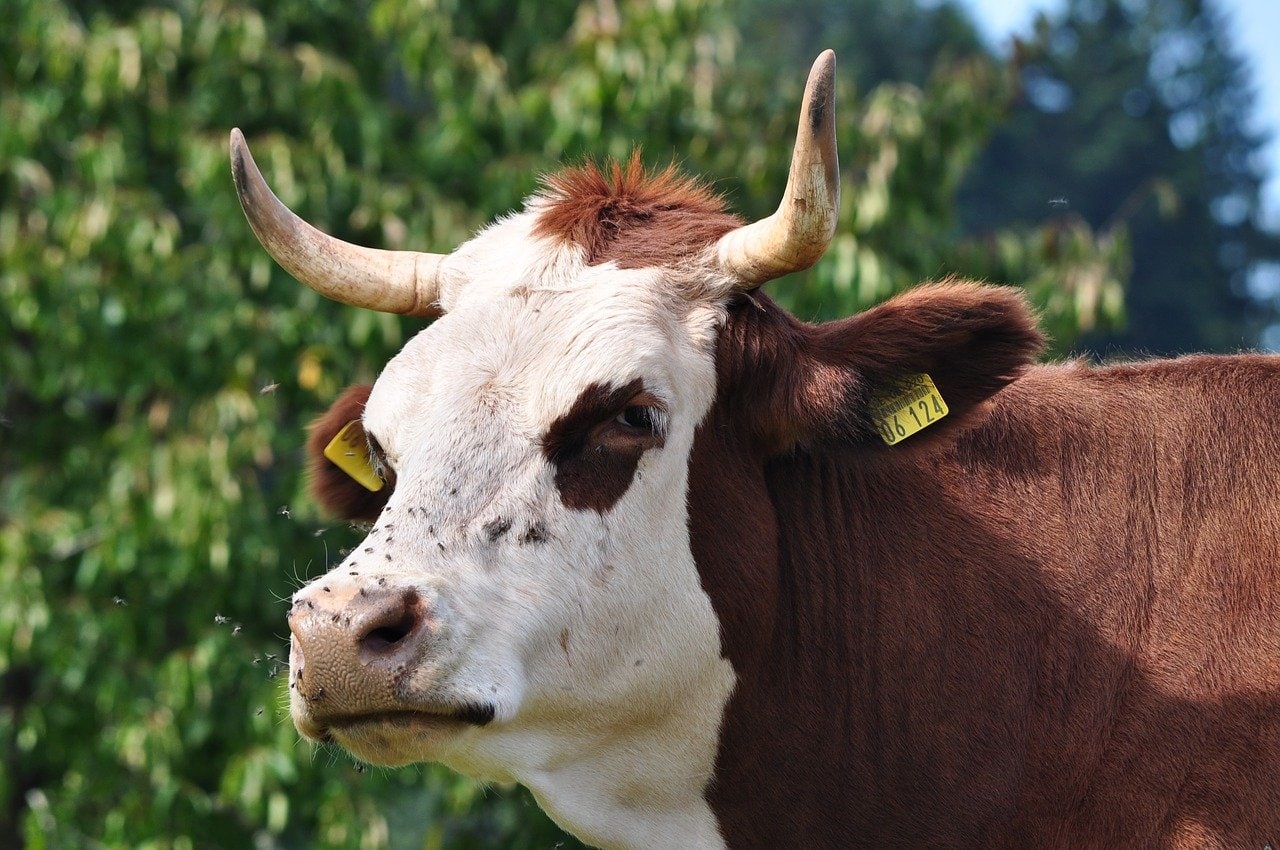
The Simmental cattle breed is a dual-purpose cow suitable for meat and milk production. However, with the introduction of new agricultural techniques in contempo years, the Simmental brood has been improved genetically to become a adept milk producer. These cattle breeds take a mixed conversion and milk production yield, making this cow the best in its field, amend than other types with the same characteristics.
Simmental colour varies from red to gold with white and can exist evenly distributed or clearly defined in spots on a white background. The head is white, and a white ring commonly appears over the shoulders. Most cows take paint around the eyes, helping to reduce middle issues that occur due to bright sunlight.
They take a big frame with excellent muscling with the cow most 135–150 cm at the withers. The weight of a Simmental breed tin vary on its use, only the moo-cow can counterbalance about 2,100 to 2,500 pounds.
Since they are a dual-purpose breed with the highest fertility operation in milk production, Simmental cows are practiced milk producers. On boilerplate, they can produce nearly 9,000 liters per lactation.
Related Read: Do Cows Make Good Pets? Everything You Demand to Know!

Final Thoughts
Some dairy cow breeds have efficiently specialized in milk production. Cattle breeds of European origin have spread across the world due to their numerous characteristics and benefits.
Each dairy moo-cow breed comes with unique strengths and weaknesses that may play in your favor or work against y'all, depending on your homestead, your land and resources, and your requirements. The cow breeds mentioned above are perfect for homesteaders. Some need prior moo-cow treatment experience, but others don't and are easy to handle.
Even so, keep in mind that milk production is linked to the surround where a moo-cow stays. Factors that make up one's mind a cow's milk product include temperature, soil type, soil inclination, provender of the region, luminosity, and rainfall.
Featured Image Credit: PublicDomainPictures, Pixabay
Source: https://petkeen.com/best-dairy-cow-breeds-for-milk/
0 Response to "Dairy Cow White Background You Wanna Know Who I Like Read the First Word Again"
Post a Comment